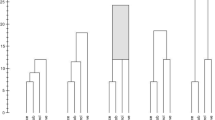Abstract
We propose a generative probabilistic approach to constructing topographic maps of sequences and tree-structured data. The model formulation specifies a low-dimensional manifold of local noise models on the structured data. The manifold of noise models is induced by a smooth mapping from a low dimensional Euclidean latent space to the parameter space of local noise models. In this paper, we consider noise models endowed with hidden Markovian state space structure, namely Hidden Markov Tree Models (HMTM) and Hidden Markov Models (HMM). Compared with recursive extensions of the traditional Self-Organizing Map that can be used to visualize sequential or tree-structured data, topographic maps formulated within this framework possess a number of advantages such as a well defined cost function that drives the model optimization, the ability to test for overfitting and the accommodation of alternative local noise models implicitly expressing different notions of structured data similarity. Additionally, using information geometry one can calculate magnification factors on the constructed topographic maps. Magnification factors are a useful tool for cluster detection in non-linear topographic map formulations. We demonstrate the framework on two artificial data sets and chorals by J.S. Bach represented as sequences, as well as on images represented as trees.
Preview
Unable to display preview. Download preview PDF.
Similar content being viewed by others
References
Kohonen, T.: The self-organizing map. Proceedings of the IEEE 78(9), 1464–1480 (1990)
Hammer, B., Micheli, A., Strickert, M., Sperduti, A.: A general framework for unsupervised processing of structured data. Neurocomputing 57, 3–35 (2004)
Svensén, M.: GTM: The Generative Topographic Mapping. Ph.D thesis, Aston University, UK (1998)
Kabán, A., Girolami, M.: A combined latent class and trait model for the analysis and visualization of discrete data. IEEE Transactions on Pattern Analysis and Machine Intelligence 23(8), 859–872 (2001)
Kleiberg, E., van de Wetering, H., van Wijk, J.J.: Botanical visualization of huge hierarchies. In: IEEE Symposium on Information Visualization, INFOVIS, pp. 87–94 (2001)
Chappell, G., Taylor, J.: The temporal kohonen map. Neural Networks 6, 441–445 (1993)
Koskela, T., Heikkonen, M.V.z.J., Kaski, K.: Recurrent SOM with local linear models in time series prediction. In: 6th European Symposium on Artificial Neural Networks, pp. 167–172 (1998)
Horio, K., Yamakawa, T.: Feedback self-organizing map and its application to spatio-temporal pattern classification. International Journal of Computational Intelligence and Applications 1(1), 1–18 (2001)
Voegtlin, T.: Recursive self-organizing maps. Neural Networks 15(8-9), 979–991 (2002)
Strickert, M., Hammer, B.: Merge SOM for temporal data. Neurocomputing 64, 39–71 (2005)
Hagenbuchner, M., Sperduti, A., Tsoi, A.C.: A self-organizing map for adaptive processing of structured data. IEEE Transactions on Neural Networks 14(3), 491–505 (2003)
Hagenbuchner, M., Sperduti, A., Tsoi, A.C.: Contextual processing of graphs using self-organizing maps. In: Proceedings of the European Symposium on Artificial Neural Networks (ESANN), pp. 399–404 (2005)
Heskes, T.: Energy functions for self-organizing maps. In: Oja, S., Kaski, E. (eds.) Kohonen Maps, pp. 303–315. Elsevier, Amsterdam (1999)
Bishop, C.M., Svensén, M., Williams, C.K.I.: GTM: The generative topographic mapping. Neural Computation 10(1), 215–234 (1998)
Rabiner, L.R.: A tutorial on hidden markov models and selected applications in speech recognition. Proceedings of the IEEE 77(2), 257–286 (1989)
Gianniotis, N., Tiňo, P.: Visualisation of tree-structured data through generative topographic mapping. IEEE Transactions on Neural Networks (2008) (in press)
Crouse, M., Nowak, R., Baraniuk, R.: Wavelet -Based Statistical Signal Processing Using Hidden Markov Models. IEEE Transactions on Signal Processing 46(4), 886–902 (1998)
Durand, J.B.: Gonçalvès, P.: Statistical inference for hidden Markov tree models and application to wavelet trees. Technical Report 4248, INRIA (2001)
Durand, J.B., Gonçalvès, P., Guedon, Y.: Computational methods for hidden markov tree models-an application to wavelet trees. IEEE Transactions on Signal Processing 52(9), 2552–2560 (2004)
Tiňo, P., Kaban, A., Sun, Y.: A generative probabilistic approach to visualizing sets of symbolic sequences. In: KDD 2004: Proceedings of the tenth ACM SIGKDD international conference on Knowledge discovery and data mining, pp. 701–706. ACM Press, New York (2004)
Bishop, C.M., Svensén, M., Williams, C.K.I.: Magnification factors for the gtm algorithm. In: Proceedings IEE Fifth International Conference on Artificial Neural Networks, pp. 64–69 (1997)
Cover, T.M., Thomas, J.A.: Elements of information theory. Wiley-Interscience, Hoboken (1991)
Kullback, S.: Information theory and statistics. Wiley, New York (1959)
Tiňo, P., Gianniotis, N.: Metric properties of structured data visualizations through generative probabilistic modeling. In: IJCAI 2007: 20th International Joint Conference on Artificial Intelligence, pp. 1083–1088. AAAI Press, Menlo Park (2007)
Do, M.N.: Fast approximation of Kullback-Leibler distance for dependence trees and hidden markov models. IEEE Signal Processing Letters 10(4), 115–118 (2003)
Merz, C., Murphy, P.: UCI repository of machine learning databases (1998)
Hagenbuchner, M., Tsoi, A.: The traffic policeman benchmark. In: Verleysen, M. (ed.) European Symposium on Artificial Neural Networks, April 1999, pp. 63–68. D-Facto (1999)
Kabán, A., Girolami, M.: A combined latent class and trait model for the analysis and visualization of discrete data. IEEE Transactions on Pattern Analysis and Machine Intelligence 23(8), 859–872 (2001)
Author information
Authors and Affiliations
Editor information
Editors and Affiliations
Rights and permissions
Copyright information
© 2009 Springer-Verlag Berlin Heidelberg
About this chapter
Cite this chapter
Gianniotis, N., Tiňo, P. (2009). Visualization of Structured Data via Generative Probabilistic Modeling. In: Biehl, M., Hammer, B., Verleysen, M., Villmann, T. (eds) Similarity-Based Clustering. Lecture Notes in Computer Science(), vol 5400. Springer, Berlin, Heidelberg. https://doi.org/10.1007/978-3-642-01805-3_7
Download citation
DOI: https://doi.org/10.1007/978-3-642-01805-3_7
Publisher Name: Springer, Berlin, Heidelberg
Print ISBN: 978-3-642-01804-6
Online ISBN: 978-3-642-01805-3
eBook Packages: Computer ScienceComputer Science (R0)




